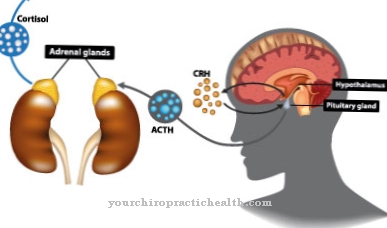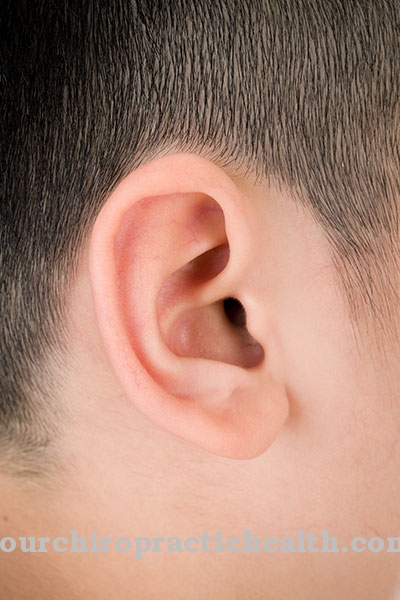At a somnambulism It is a sleep disorder that is colloquially known as sleepwalking. The cause of this disorder is largely unknown. It mainly affects children.
What is somnambulism?

© milkovasa - stock.adobe.com
Of the somnambulism denotes a state in which the person concerned walks around while sleeping and may also perform complex actions. As a sleep disorder, this disorder belongs to the group of parasomnias. As a rule, the person concerned does not remember it later or there are only bits of memory. Colloquially in somnambulism, Sleepwalking or Lunar addiction spoken.
In the past, due to its brightness, the full moon was seen as the trigger for nighttime activities. The sleepwalking event usually only lasts a few minutes. Mainly children (10 to 30 percent) are affected. After puberty, the tendency to sleepwalk in most cases disappears. In adults, there are only one to two percent chronic sleepwalkers. Somnambulism is not a serious illness, but usually a harmless disorder of waking up. However, in stubborn cases, there is a risk of injury from falling.
causes
Little is known about the causes of somnambulism. The finding that mainly children are affected suggests a maturation problem of the central nervous system. During childhood and adolescence, the process of maturation within the nervous system is not yet complete.When puberty ends, the somnambulism that is typical for many children and adolescents usually ends.
In only one to two percent of cases, it continues to occur in adulthood. Sometimes the condition becomes chronic. In some cases, it rarely happens. There are even cases where somnambulism first appears in adulthood. It has been established with certainty that the cause of sleepwalking has a genetic component. Somnambulism is more common in some families. Stress and other stressful situations are also suspected as triggering factors.
Soothing medication, fever, waking nights or alcohol consumption can also trigger the sleep disorder. Somnambulism never occurs during dream sleep (REM sleep) but always during deep sleep or normal sleep. The assumption here is that the waking process is not complete after an internal or external wake-up stimulus.
This creates an intermediate state in which part of the brain is awake while the other areas of the brain are still asleep. Complex actions can be performed in this situation. It has not yet been possible to clarify why the wake-up process is not complete.
Symptoms, ailments & signs
Somnambulism manifests itself by walking around during deep sleep, non-reaction to external stimuli, rigid facial expressions and difficult waking ability. In rare cases, aggressive behavior can occur. After a few minutes, the sleepwalker usually returns to bed and continues to sleep. Sleepwalking usually takes place in the first third of the night. The activity is intensified by stimuli such as light or noise.
A distinction must be made between four forms of somnambulism:
- There is not always activity in the subclinical form. However, corresponding brain activities can be detected in the electroencephalogram (EEG), in the electrocardiogram (EKG) and in the electromyogram (EMG).
- In the so-called abortive form of somnambulism, activities are limited to the bed. The person concerned either just sits down or speaks indistinctly in their sleep.
- In classic somnambulism, the person concerned wanders around in his sleep, sometimes carries out complex actions and exposes himself to the risk of injury by not reacting to external stimuli.
- In rare cases, an aggressive to violent course occurs. However, it is precisely here that there is a risk of confusion with other forms of sleep disorders, which are often based on much more serious psychological illnesses.
Diagnosis & course of disease
Somnambulism is usually a harmless sleep disorder. However, it must be differentiated from other, much more serious sleep disorders in a differential diagnosis. There are certain forms of epilepsy that occur at night and can be confused with somnambulism. Furthermore, certain REM sleep disorders (Schenck syndrome) can simulate the aggressive form of somnambulism.
Here, however, the activities occur during the dream sleep, whereby the patient reacts aggressively to dream contents and can sometimes also remember later. Other exclusion diagnoses are states of confusion in dementia as well as psychological exceptional states. A reliable diagnosis of somnambulism can be made using an electroencephalogram, electrocardiogram or electromyogram.
Complications
Somnambulism itself is not a problem in most cases. While sleepwalking, however, there is an increased risk of accidents and falls. During nighttime activities, for example, the person affected may fall from the stairs, trip over or switch on the stove.
If the sleepwalker is woken up, this can trigger a shock and possibly a heart attack. Occasionally those affected become physical because they cannot differentiate between dream and reality. In adults, somnambulism can indicate diseases of the brain. It cannot be ruled out that sleepwalking is caused by a neurological disorder or even a brain tumor - both of which must be treated before further complications set in.
Sedatives or sleeping pills are usually prescribed for sleepwalking, which are always associated with side effects and interactions. Benzodiazepines and antidepressants also harbor risks. If a possibly existing mental illness is not recognized, the medication can lead to an intensification of the symptoms. In most cases, well-being then also decreases and the quality of life decreases. Behavioral therapy usually runs without complications, but should still be carried out under the guidance of an expert.
When should you go to the doctor?
In most cases, sleepwalking does not require a doctor. It is often a temporary or one-off occurrence that does not require any action. If there are no further irregularities or behavioral problems, a doctor does not always have to be consulted. In a large number of cases, the person concerned finds their way back to bed without further complications and does not need any help.
Consultation with a doctor is indicated as soon as there are regular or recurring nocturnal problems. Daytime tiredness, exhaustion or a decrease in mental or physical performance are indications that should be followed up. If sleep disorders, anxiety or inner restlessness occur, the symptoms should be clarified. If behavioral abnormalities, an aggressive demeanor or changes in personality appear, a doctor or therapist is recommended.
If there are various stress factors, if well-being is reduced or if the person concerned is withdrawing, a doctor should be discussed about the developments. In dangerous situations or self-destructive actions, consultation with a specialist is advisable. The person concerned and the relatives need advice on how to deal with the sleepwalker correctly and should optimize sleep hygiene so that everyone involved can relax.
Therapy & Treatment
During the activity phase of somnambulism, the person affected should not be woken up because disorientation increases the risk of injury. Panic reactions can even occur. Only in cases where the sleepwalker enters a danger zone should he be spoken to softly and gently led to the bed. It is important to ensure that the bedroom is always dark, as sleepwalkers react to light.
If sleepwalking is common, the risk of injury should be minimized by locking windows and doors and removing sharp-edged objects. There is no known therapy for the treatment of somnambulism.
Aftercare
Dealing with sleepwalkers is a particular challenge for relatives in everyday life. In order to protect those affected from possible accidents, it is important to prevent dangerous situations. On the one hand, you have to prevent the sleepwalker from running away while sleeping, but at the same time escape routes have to be kept open so that you can act quickly in the event of danger.
Stress has a negative impact on sleepwalkers. It is therefore important for those affected to reduce stress factors in everyday life and, ideally, to minimize them in advance. Excessive demands and emotional stress often make somnambulism worse and must be overcome. Therapeutic support can be very helpful for the sick person.
It is also important to familiarize those around the person with the disease in order to avoid unnecessary complications. Optimal sleep hygiene also helps to improve the situation. Day and night rhythms should be routine and adapted to the needs of the sleepwalker.
In the sleepwalking phase, the person concerned should not be emphatically awakened. Often it is enough just to speak gently to the sleepwalker to get him back to bed and to keep him from further activities. Since those affected often have memory gaps, they should be informed about the event afterwards.
You can find your medication here
➔ Medication for sleep disordersprevention
There are some measures that can be taken to prevent the active phases of somnambulism. The risk can be minimized through good sleep hygiene. For example, the person affected should keep to his sleep rhythm, avoid sleep deficits and avoid taking an afternoon nap. Cognitive behavioral therapy has proven itself in the event of stress or existing conflicts. Certain relaxation methods such as autogenic training or progressive muscle relaxation can also show good results in the treatment of somnambulism.
You can do that yourself
Dealing with sleepwalkers is a particular challenge in everyday life. On the one hand, adequate protection against possible accidents or running away in sleep should be guaranteed. On the other hand, escape routes are to be kept open and accessible in emergencies so that no dangerous situation arises. Therefore, it is often not easy to find a good balance for everyone involved.
The person affected can reduce stressors in everyday life. These have a negative impact on the sleepwalking process and should therefore be minimized. Conditions of emotional stress or excessive demands must be overcome or should be treated therapeutically. In addition, the immediate environment must be informed about the processes and possibilities of sleepwalking. Correct handling of the person affected is important so that no complications arise. It has been shown that an optimization of sleep hygiene contributes to an improvement in the overall situation. Therefore, day and night rhythms should be adapted to the needs of the body and routine processes should take place.
All parties involved must remain calm in the situation. Under no circumstances should the sleepwalker be forcefully awakened. Often light communication and a request to go back to bed are enough to dissuade the sleepwalker from further plans. Since the memory is then clouded, the person concerned needs to be informed.

.jpg)


.jpg)



















.jpg)



